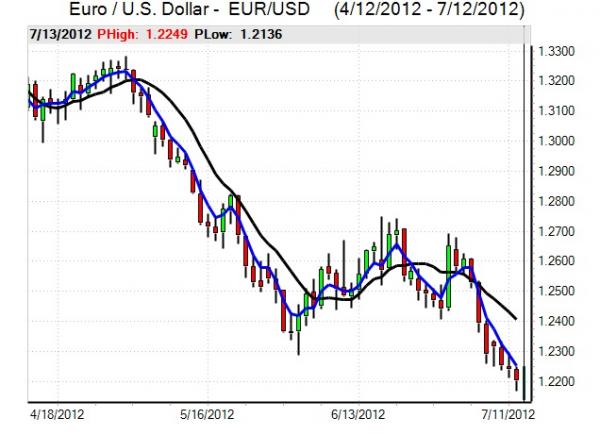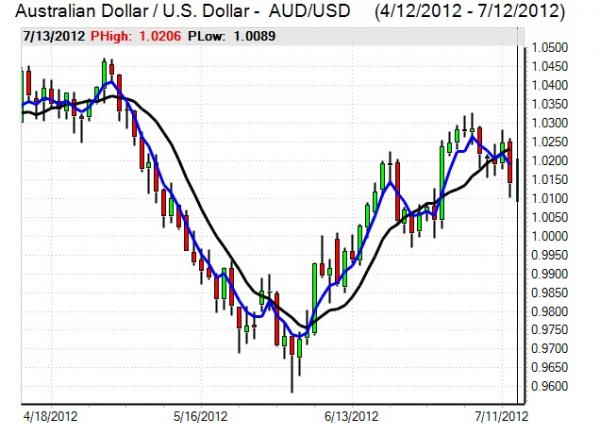EUR/USD
The Euro was blocked in the 1.2230 region early in the European session on Thursday and retreated to test support in the 1.22 region. Technical considerations remained important as players looked to take out stop-loss orders.
There was a sharp decline in deposits held at the ECB according to the latest data as the new maintenance period started. In this context, the central bank decision last week to cut the deposit rate to zero had an important impact with pressure to reallocate funds elsewhere. There had been some speculation that funds could be switched into risk assets, but there was no evidence of support for equity markets and the Euro was still subjected to further selling pressure with increased speculation that the Euro would be used as a funding currency.
The Spanish austerity measures remained an important focus amid expectations that recession conditions would continue until 2014 with the continuing threat of political protests. There were further warnings over regional budget deficits. Moody’s also downgraded the Italian credit rating to Baa2 which is only two notches above junk.
There was strong evidence that banking-sector de-leveraging had had an important impact in boosting the Euro during the first few months of 2012 and any slowdown in repatriation of funds into Europe would undermine the Euro.
There was further evidence of flows into defensive instruments such as AAA-rated bonds. The yield on Dutch 2-year bonds moved into negative territory, matching the trend in German and Swiss bonds. In this environment, the Euro retreated to fresh 2-year lows below 1.22 ahead of the US open.
US jobless claims fell to 350,000 in the latest reporting week which was the lowest since the first quarter of 2008. Although the dollar failed to derive much immediate benefit from the data, there was further speculation that the US economy would out-perform in the short term which reinforced a lack of underlying Euro support. From lows below 1.2170, the currency edged back to the 1.22 area with no major changes in Asia on Friday.

Source: VantagePoint Intermarket Analysis Software
Call now and you will be provided with FREE recent forecasts
that are up to 86% accurate* 800-732-5407
If you would rather have the recent forecasts sent to you, please go here
Yen
The yen quickly regained ground following the Bank of Japan policy meeting and the US currency was unable to regain any support during the New York session with a test of support in the 79.20 region.
With the ECB taking action to cut the deposit rate to zero and speculation that there could be additional Federal Reserve measures to boost quantitative easing, there was a shift in relative yield considerations in favour of the yen even though the Bank of Japan keeps interest rates near zero. There was the potential for relative yen out-performance, especially with the Swiss National Bank also blocking currency gains.
The dollar was able to resist further selling pressure on Friday with relief over the Chinese GDP data curbing immediate yen demand.
Sterling
Sterling initially found support close to 1.5450 against the dollar on Thursday, but it was unable to make any fresh impact on resistance levels and it dipped to 1-month lows and a test of support levels below 1.54 with wider buying support for the US currency.
UK benchmark yields fell to fresh record lows at the latest Gilt auction with a yield below 1.75% which reinforced speculation that there was defensive flows into UK bonds as capital continued to retreat from peripheral markets.
There was a continuing lack of confidence in the domestic economy which curbed demand for the currency, especially with fears that there would be additional pressure on the government finances. There will be long-term fears that the natural response will be for a weaker UK currency.
Swiss franc
The dollar maintained a strong tone against the franc on Thursday and pushed to a high near 0.9870, the highest level since December 2011, before a slight correction weaker. There was no relief for the Euro as it dipped slightly closer to the 1.20 minimum level with speculation that central bank intervention was increasing.
There will be increased pressure on the National Bank if it is forced to intervene more aggressively to protect the Euro minimum level. There will be increased speculation over some form of capital controls to curb inflows.

Source: VantagePoint Intermarket Analysis Software
Call now and you will be provided with FREE recent forecasts
that are up to 86% accurate* 800-732-5407
If you would rather have the recent forecasts sent to you, please go here
Australian dollar
The Australian dollar remained firmly on the defensive during Thursday and dipped to test support below the 1.01 level ahead of the US open. Underlying risk appetite continued to deteriorate during the day which had a negative impact on the Australian currency, especially with increased fears surrounding the global economic outlook amid expectations in all major areas.
There was some relief surrounding the latest Chinese GDP data with a figure of 7.6% which helped curb further selling pressure on the Australian currency with a rally to the 1.0170 region against the US currency.



